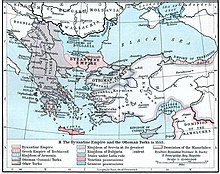Byzantine Civil War (1352-1357)
The Byzantine Civil War from 1352 to 1357 was a series of conflicts for supremacy in the Byzantine Empire between Emperor John VI. Kantakuzenos or his eldest son Matthaios Kantakuzenos and Johannes V. Palaiologos .
prehistory

After his victory in the Byzantine Civil War from 1341 to 1347 , John VI. Kantakuzenos forced his opponents to an agreement by which he became co-emperor alongside John V Palaiologos, whose father-in-law and sole ruler when he was a minor. In May 1352 John V demanded his share of power in Constantinople . John VI assigned him areas in Thrace , which, however, also included the city of Didymoticho and most of the area that he had already assigned to his son Matthaios Kantakuzenos as an apanage . Matthaios opposed this and at the same time questioned John Palaiologos as the rightful heir to the throne.
course
In the summer of 1352, John V began the civil war, perhaps to forestall an attack. He crossed the border to the area administered by Matthaios and besieged Adrianople in autumn 1352 . John VI came to his son with troops of the Ottoman Sultan Orhan I to help. The Turks recaptured some of the cities that had previously surrendered to the paleologists and plundered them with Kantakuzenos' approval, including Adrianople. Johannes V had to withdraw to Serbia .
For a counter-offensive, Johannes V. Palaiologos asked the Serbs and Bulgarians for arms help. While the Bulgarians did not keep their promise in view of the Turkish superiority, the Serbian Tsar Stefan Dušan raised a 4,000-strong cavalry army against the Ottomans. In return, Johannes V handed his brother Michael over to the court of the Serbian emperor as a hostage . Orhan I. sent the enormous force of 10,000 cavalrymen into the field under the command of his son Suleyman . The two armies met in an open field battle near Didymoticho in October 1352 , with the numerically superior Ottomans inflicting a heavy defeat on the Serbs.
John VI Kantakuzenos initially asserted rule over Byzantium through the victory of his Ottoman allies. John V Palaiologos and his family went into exile on the Venetian island of Tenedos . After a failed attempt to return, John VI withdrew him. Succession to the throne in April 1353 and elevated his son Matthaios to co-emperor. The Patriarch of Constantinople , Callistus I , who refused to crown Matthew, was replaced by Philotheos Kokkinos , who performed the ceremony in February 1354.
From Thessaloniki , John V forced the recapture of Constantinople in October 1354 with Genoese support. The Panhypersebastos Andronikos Asanes sent an army from Bizye to help Kantakuzenos , but without being able to prevent the deposition of his uncle in December 1354.
Matthaios Kantakuzenos continued the war against John V from Thrace. When attempting to take the Serbian capital Serres with the help of 5000 Turks , he was captured by the voivode Vojihna in the spring of 1357 , later handed over to John V on payment of a large ransom , and forced by him to abdicate in December 1357.
consequences
John V Palaiologos had asserted himself as sole ruler in the civil war, but at a high price. The first military success of the Ottoman Empire on European soil was to pave the way for further Turkish expansion and the "encirclement" of Constantinople, which began in 1354 with the conquest of the Gallipoli peninsula and ultimately led to the fall of Byzantium a century later .
swell
- Nikephoros Gregoras 3, 177–183 and passim (ed. Ludwig Schopen , CSHB , 1830)
- Johannes Kantakuzenos 3, 200–364 passim (ed. Ludwig Schopen, CSHB Vol. 9, 1832, reprint 2012)
literature
- John Van Antwerp Fine: The Late Medieval Balkans: A critical Survey from the late Twelfth Century to the Ottoman Conquest. University of Michigan Press, Ann Arbor MI 1994, ISBN 0-472-08260-4 .
- Donald M. Nicol : The Last Centuries of Byzantium, 1261-1453. Cambridge University Press, Cambridge 1993, ISBN 0-521-43991-4 .
- Georg Ostrogorsky : History of the Byzantine State (= Handbook of Classical Studies . Dept. 12: Byzantine Handbook . Vol. 1,2). CH Beck, Munich 1940, 3rd revised edition 1963, ISBN 3-406-01414-3 .
- George Christos Soulis: The Serbs and Byzantium during the reign of Tsar Stephen Dušan (1331-1355) and his successors. Dumbarton Oaks Research Library and Collection, Washington DC 1984, ISBN 0-88402-137-8 , OCLC 59251762 .
- Warren Treadgold : A History of the Byzantine State and Society. Stanford University Press, Stanford CA 1997, ISBN 0-804-72630-2 .
Remarks
- ↑ See Fine, Late Medieval Balkans , p. 325.
- ↑ See Nicol, Last Centuries , p. 238.
- ↑ See Fine, Late Medieval Balkans , p. 325; Treadgold, History , pp. 775 f.
- ↑ See Ostrogorsky, Geschichte , p. 437; Soulis, Serbs , p. 50 f.
- ↑ Cf. Fine, Late Medieval Balkans , pp. 325 f.
- ↑ See Treadgold, History , pp. 775-778.
- ↑ See Fine, Late Medieval Balkans , p. 326.

